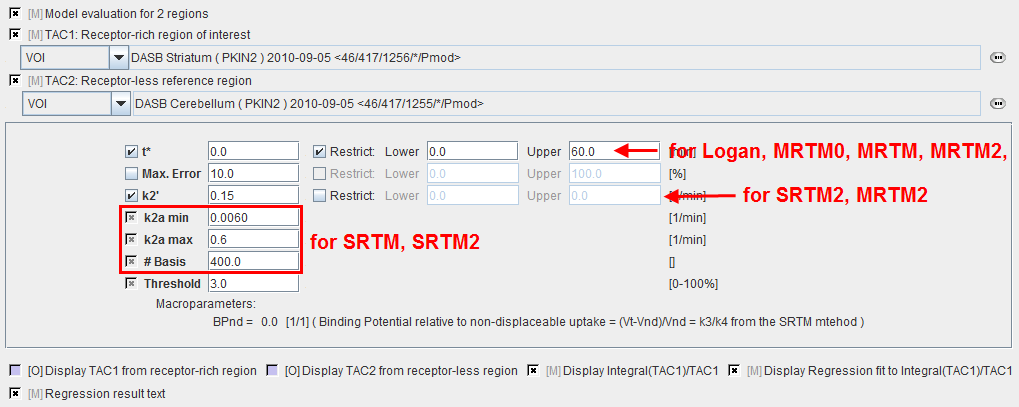Acquisition and Data Requirements
Image Data |
A dynamic PET data set with an appropriate neuroreceptor tracer. |
TAC 1 |
TAC from a receptor-rich region (such as basal ganglia for D2 receptors). |
TAC 2 |
TAC from a receptor-devoid region (such as cerebellum or frontal cortex for D2 receptors). |
Model Preprocessing
Two regional TACs (TAC1 and TAC2) are needed for Model Preprocessing.

t* |
Start time of the data segment used for the estimation of BPnd. If the box of t* is checked it is fitted using the Logan Reference method and the specified Max. Err. criterion. Otherwise, the specified t* value is applied. Note that all methods requiring a t* will use the same value from this preprocessing step. |
Max. Err. |
Maximal allowed relative error between measurement and prediction in the data segment starting from t*. |
k2' |
k2 of the reference tissue. It can be fixed at a specified value, or fitted using SRTM. This value will be used by SRTM2 and MRTM2 in the pixel-wise calculation. |
k2a min |
Minimal value of k2a = k2/(1+BP) (slowest decay of exponential). Is used for creating the SRTM and SRTM2 basis functions. |
k2a max |
Maximal value of k2a = k2/(1+BP) (fastest decay of exponential). Is used for creating the SRTM and SRTM2 basis functions. |
# Basis |
Number of basis functions between k2a min and k2a max. Note that increments are taken at logarithmic steps. This number has a big impact on processing time. |
BPnd |
Binding potential (= k3/k4 according to the underlying model) estimated by STRM. |
The result of the fit during preprocessing is shown in the preprocessing Results panel.

Note that the Model Preprocessing of all models is shown in the Info are and can be inspected by scrolling the window.
Map Parameters

BPnd_X |
Binding potential estimated with the methods X = SRTM, SRTM2, Logan, MRTM2, MRTM, MRTM0 |
R1_X |
Ratio of tracer delivery in each pixel relative to the reference tissue (RI=K1/K1'). This map is often similar to a perfusion image and can therefore be helpful as an anatomical reference. |
k2_X |
Estimated efflux rate constant k2. |
k2a_X |
Map of the k2a value which provides the best fit. |
k2'_MRTM |
k2 of the reference tissue which is fitted by MRTM in each pixel. It will show variation, although it should be constant as always the same reference tissue is used. |
Note: The k2a parametric map should be checked in the initial setup of a processing protocol. The estimated k2a values should not be truncated by too narrow k2a min and k2a max values.